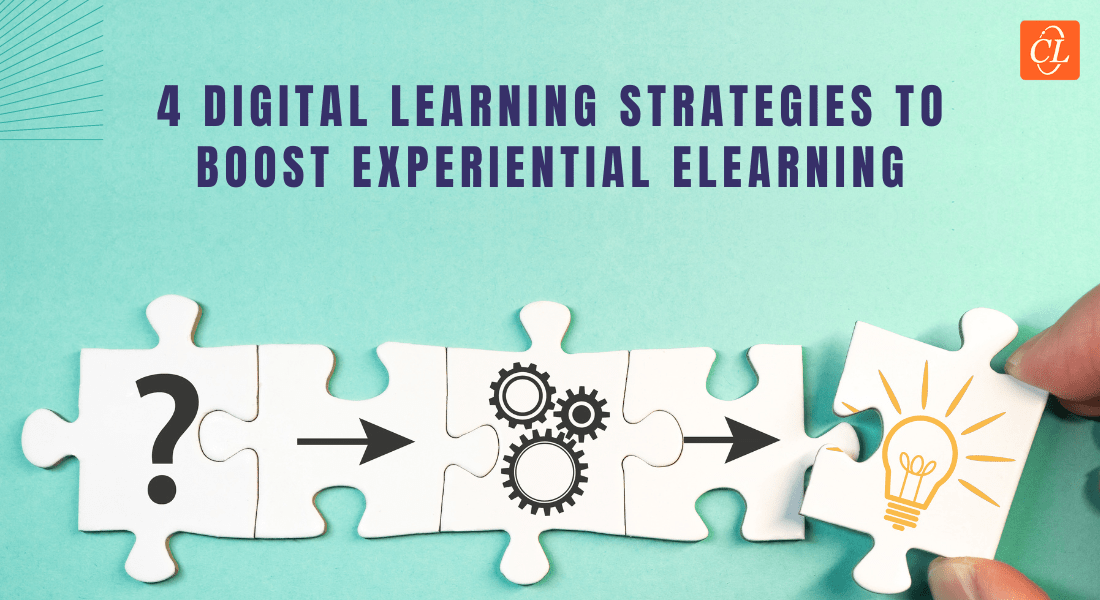4 Popular Digital Learning Strategies to Integrate with Experiential eLearning

Are texts and tutorial slides enough for corporate employees to grasp the required knowledge and practical expertise to perform various daily tasks at work? No, I guess! Because there are a lot of corporate training sessions that require the learners to experience the work in real-time and perfect their skills by practicing a task multiple times. Most organizations have their workforce spread globally so being limited to experiential learning for classroom training can make it unfair for remote employees, hence the same concept is incorporated with various eLearning formats. This blog will brief you on the benefits of experiential eLearning and 4 digital learning strategies that can be integrated with it.
Confused About How to Use Experiential eLearning Effectively?
It connects well with these learning strategies:
- Virtual Instructor-led Training
- Gamification
- Augmented Reality & Virtual Reality
- Social Learning
Read on to explore the amazing benefits of experiential eLearning.
4 Popular Learning Strategies to Integrate Experiential eLearning
1. Virtual Instructor-led Training
It’s a synchronous form of training where learners and instructors are involved in real-time. To integrate experiential eLearning with VILT, you can try demonstrating a task through screencast and the learners can do the same on their screens. For example, installing an anti-virus, setting up a VPN connection, or learning a software program.
Explore how you can generate motivation and excitement in a virtual classroom!
2. Gamification
The process of incorporating game elements such as levels, scores, and collectibles in a digital learning environment is called gamification. You can create gamified assessments to increase knowledge retention and make training fun and competitive. For example, create a time-based challenge at the end of each level and make the course challenging, and eventually more engaging.
3. Augmented Reality & Virtual Reality
It helps the learner explore real-world situations virtually through simulations and scenarios. A lot of training sessions such as machinery training, software training, and product training can be facilitated through these technologies as they allow the learner to practice the various tasks in a sandbox environment until they perfect it.
4. Social Learning
To facilitate experiential eLearning, it is probably the best strategy as it enables learning with peers in a healthy work environment. You can observe others performing a task or an activity and get the required help instantly when needed. Social learning helps the learners amplify their soft skills such as teamwork, communication, critical thinking, etc.
4 Amazing Benefits of Experiential eLearning
Experiential eLearning adapts the narrative of learning by doing, but virtually. It’s basically the classic trial and error method to understand a concept or a process and perfect it by attempting it multiple times and improvising on your mistakes. It is quite beneficial in today’s era of digitalization and the involvement of various technologies makes its implementation and execution even more hassle-free. Some of its benefits are as follows –
1. Facilitates change in learner’s behavior and mindset
When employees are exposed to prolonged and monotonous traditional training sessions, it puts a lot of restrictions on their learning freedom, creativity, and upskilling potential. To improve the mindset of learners regarding learning and development and enhance their engagement in training, experiential eLearning is quite impactful. Learners fail multiple times here but instead of dropping out, they learn from their mistakes, eventually enhancing their interest in learning, upskilling, and becoming more productive at work. This enhances the learning culture in an organization as it makes the training more interesting and promotes a healthy work environment.
2. Helps the learners with knowledge retention
As we already discussed, learners attempt to perfect a task or understand a process by performing it instead of reading or listening about it. Modern learners follow a more direct approach toward their learning and their curiosity about learning new things pops out only when they practice them in real-time. Experiential eLearning helps modern learners perform a task or a process virtually until they become eligible to do it perfectly. This enhances their knowledge retention to a great extent as the human brain tends to remember first-hand interactions more clearly because muscle memory responds to activities that are practiced multiple times.
3. Bridges the gap between theoretical knowledge and practical expertise
Let’s understand this with a simple example, you read a book that explains how to climb a mountain or how to sail a ship, but is it enough for you to perform that task? Not at all! Hence, bridging the gap between theoretical knowledge and practical expertise is necessary and experiential eLearning does that effectively. It follows a simple approach where learners first understand a concept, then practice it, which also makes their learning interesting and motivates them to perform better than the previous attempt. Integrating it with multiple digital learning strategies minimizes the gap even more by adhering to the various learner preferences.
4. Allows precise assessment of work-related skills
You can analyze a lot of data, how many times a learner attempted a certain task, what was the average time for task completion, or simply track the course completion rate, etc, with the help of learning analytics. The results of your experiential eLearning will be displayed more accurately and the employees can have a clear idea of what are their strong points and what skills are supposed to be polished.
Wrapping Up!
eLearning is surely a gift of technology as it can be incorporated with various other concepts and methodologies to facilitate impactful corporate training. Experiential learning is one such philosophy that can be combined with eLearning to make various types of training sessions engaging and interactive. Are you excited to know in detail about the instructional designs mentioned above? If yes, you can check out this insightful eBook.





![Role of Simulations in Modern Software Training [Infographic]](https://blog.commlabindia.com/hubfs/blogs/software-training-simulations-enhance-infographic.jpg)